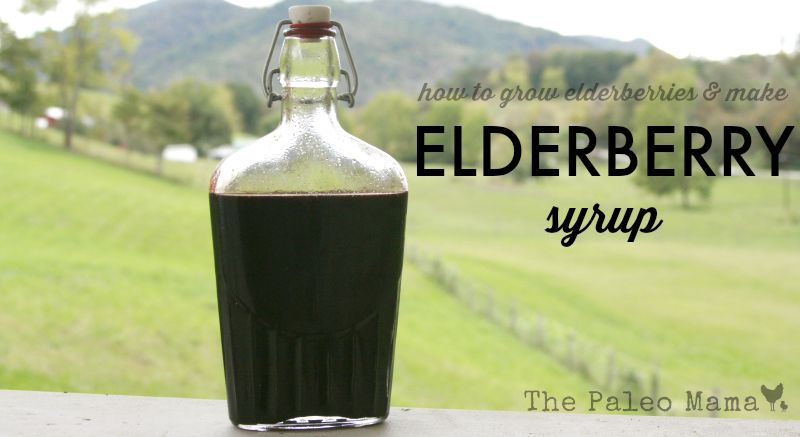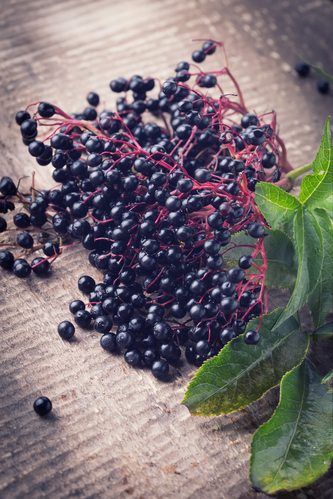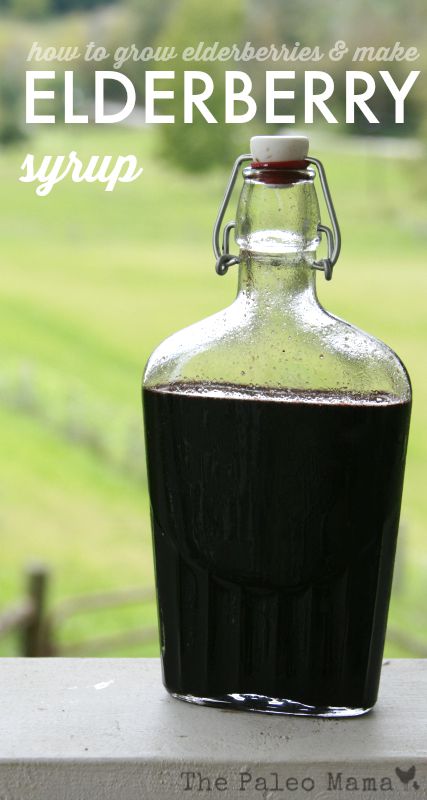
Elderberries are one of the most sustainable crops, and is being farmed by many farmers who are interested in nutritious, home-grown and organic farming. It is packed with Vitamins A, B, and C, iron, potassium, and powerful antioxidants. The plants are a hardy perennial, and are naturally disease resistant. Surprisingly, only 10 percent of the elderberries consumed in the United States are actually grown here. Making a elderberry syrup recipe is a great way to get all the nutrition from these delicious bushes into our body!
Our farm wants to be a part of the group that wants to change that statistic. We are so happy to have some elderberry bushes on our farm already, and we plan to add more. I’ve already made my own homemade Elderberry Syrup and hope to have many more elderberries to harvest next Fall.
In this blog post I want to cover some of the basics in elderberry growing and harvesting and then using the berries to make an elderberry syrup. We will take a look at:
- Elderberry varieties to consider growing
- Planting new elderberry bushes
- Taking care of your elderberry bushes
- Harvesting your elderberries
- Nutritious, healthy ways to use your elderberry harvest
- Elderberry Syrup Recipe
1. Elderberry varieties to consider growing
There are several varieties of the American elderberry that are especially good fruit producers. Here are some of the best selections to try in your yard or farmland.
- Adams—This American variety grows 8 to 10 feet tall. The large, juicy, dark purple fruits ripen in August and are great for making pies. The strong branches hold the berries upright. Plant a pollinator variety such as ‘Johns’ for maximum fruiting. This variety is often sold as “Adams No. 1” or “Adams No. 2.” There is little difference between these two selections.
- Black Beauty—This striking European variety features purple foliage and lemon-scented pink flowers. It grows 6 to 8 feet tall and wide and can be grown in perennial borders or as a foundation plant.
- Black Lace—This eye-catching European selection looks like a Japanese maple with its dark purple, deeply cut foliage. Like “Black Beauty,” this variety also grows 6 to 8 feet tall and wide, producing pink flowers and dark purple fruits.
- Johns’—This early-producing American variety produces an abundance of berries that are especially good for making jelly. Growing 12 feet tall and wide, this variety is a good pollinator for “Adams.”
- Nova—This American variety can be self-fruitful, but does best with another American elderberry growing nearby. Large, sweet fruit are produced on compact, 6-foot shrubs.
- Variegated—This European variety has attractive green and white leaves and grows 6 to 8 feet tall and wide. The plant is less vigorous and productive than other elderberry varieties, but the foliage is attractive all season long.
- York—This American variety produces the largest berries of all the elderberry selections. It matures in late August and only grows 6 feet tall and wide. It pollinates “Nova” well.1
2. Planting new elderberry bushes
While your elderberry berries will grow on your bush the first year they are planted, you will want to be aware that the berries will do better the second year and each year after. The bushes will grow best in well-drained loamy soil. If your soil is sandy, you will need to add organic matter to prepare your soil. Before you plant, be sure to check your soil pH. Your local County Extension Office can supply you with the information you need for doing this.
All elderberries require cross-pollination with other varieties. Either plant two different varieties in their own spots close to each other in your garden, or plant two varieties in one hold. Since Nova and York are the two cultivars that grow the biggest crops, you may want to begin with these two, cross-pollinating them as you plant.
Here are some excellent planting tips:
- Pick a location with full sun
- Add manure or compost to your soil before planting
- Plant your elderberry bushes 6-8 feet apart in rows 10 feet apart.
- Water the plants thoroughly
- Don’t apply any fertilizer during the first year.
- Elderberries are shallow rooted: Keep them well watered the first season.
3. Taking care of your elderberry bushes

After the first year, your elderberry bushes will grow best if you fertilize annually using compost. Because they have shallow roots, mulch around the plants to control weeds that compete for water and nutrients.
Your bushes will grow suckers freely, sending up new branches each season. In the second and third years, these new branches will produce side branches that fruit heavily. In late winter, prune out branches that are more than 3 years old, leaving equal numbers of one- two- and three-year-old branches. Prune out dead or diseases branches as well.
There aren’t many significant pests or diseases affecting elderberries. However you will want to watch for cane borers and Japanese beetles. Be aware that birds love elderberries, and will compete with you to eat them before you can harvest the berries. To avoid the birds getting your harvest, cover the shrubs with netting once they begin to berry. If you are also raising chickens, your chickens can be one of your best defenses against both weeds and insects. You can also handpick the beetles, or use a natural, organic control such as AzaMax. (Here)
4. Harvesting your elderberries
In most climates, there will be a 5-15 day period in mid-August through mid-September when the berries are ripening. Be sure to pick them before the birds do! Let them ripen on the shrub to a dark purple color. Prune off the entire cluster when ripe, and strip the berries into a bowl. You will need to keep the harvest refrigerated and process the berries as soon as possible. You can get 12-15 pounds of berries from one mature 3-4 year old shrub.
5. Nutritious, healthy ways to use your elderberry harvest

As I mentioned at the start of this post, elderberries are packed with vitamins, minerals, and antioxidants. One of the best-known benefits of the black elderberries is its power to boost the immune system, because of it strong, antiviral properties. The medicinal parts of the elderberry bush include the roots, bark, young shoots, leaves, flowers, and berries. Yup—the entire plant!
The flowers are effective at reducing phlegm and encouraging sweating. They are also good for strengthening the upper respiratory track. The flowers help to soften the skin and are often added to lotions and creams. You can also make a flower poultice with them too! (Here)
Elderberries can also be used in cooking, and there are many good, nutritious elderberry food recipes that you can research for yourself.
Elderberry Syrup Recipe
If you cannot grow your own elderberry bushes, then you can still reap the benefits of this plant by purchasing dried elderberries from HERE.
I want to really encourage you to find a local honey farmer and get the MOST local raw honey you can find. It’s not necessary to have local honey, but it is essential to have RAW honey that has not been pasteurized (to destroy it’s many health benefits). I am lucky enough to have our own honeybees, so we used the honey that we harvested in July from our backyard!
INGREDIENTS:
- 2 cups of filtered water
- 2/3 cup of dried elderberries or 1.5 cup of fresh
- 1 cup of your most local raw honey you can find
- 1 teaspoon of whole clove
- 1 stick of cinnamon
- 1 knob of fresh ginger, peeled
DIRECTIONS:
- Bring the water, elderberries, and spices to a boil. Reduce to simmer on low for 30-45 minutes with a lid on.
- During the simmering, use a potato masher and frequently mash the elderberries while simmering.
- Remove the saucepan from the heat.
- Pour the honey in a separate glass jar.
- Filter the hot syrup through a sieve or cheesecloth into the honey. You might need to grab a funnel. You will want to make sure you squeeze all the liquid out from the elderberries. This is why I like using a cheesecloth and twisting to make sure it’s completely drained out .
- Stir the honey until it is dissolved. Make sure you use the hot syrup to dissolve the honey.
- Date and label the bottle and then place in the refrigerator. The honey acts as a natural preservative so you syrup should be good for several months in the fridge.
NOTES:
- Adults can take 1 tablespoon daily and children (over 1 years old) can take 1/2ts-1 ts daily.
- If feeling under the weather, adults can take 1 teaspoon every 2-4 hours and children can take 1/2 teaspoon, every 2-4 hours.
- Remember honey can cause botulism in infants!
- Cost/Savings: It cost me $2.17 if purchasing dried elderberries to make this recipe and only $$0.97 if using your own homegrown elderberries!
- This recipe makes over 3 cups of elderberry syrup! You won’t beat that price anywhere!
You will never regret your decision to try raising and harvesting elderberries. Elderberries are even better nutritionally than blueberries. They are wonderful for pies, jams, jellies, and homemade medicinal remedies. The flowers are delightful breaded and made into fritters. Join us at bringing these wonderfully versatile berries back as homegrown American treasures and enjoy the delicious and nourishing Elderberry Syrup Recipe!

Sources
- https://www.garden.org/ediblelandscaping/?page=july_elderberry
- https://normsfarms.com/aboutus/our-story/
- https://www.gardeningknowhow.com/edible/fruits/elderberry/planting-elderberry.htm
- https://www.starkbros.com/growing-guide/how-to-grow/berry-plants/elderberry-plants/planting
- https://www.healing-from-home-remedies.com/elderberry-benefits.html
Resubscribe me please
I like to read your free ebook
But I can’t subscribe for it because I unsubscribed some time ago
Thank you
This article is very misleading as the elderberry plant is actually poisonous. Only the fully ripe berries and the flowers are safe to ingest. You will get cyanide poisioning from ingesting the seeds, stems/canes, leaves or roots. Even unripened berries can be mildly poisonous.
I harvested my black elderberries a tad too early. They’re mostly dark purple but some are still dark reddish. Can I still use for syrup or have I wasted them all?
Which black elderberry bush varieties do you recommend for medicinal purposes?
Any of the varieties about can be used for it’s medicine.